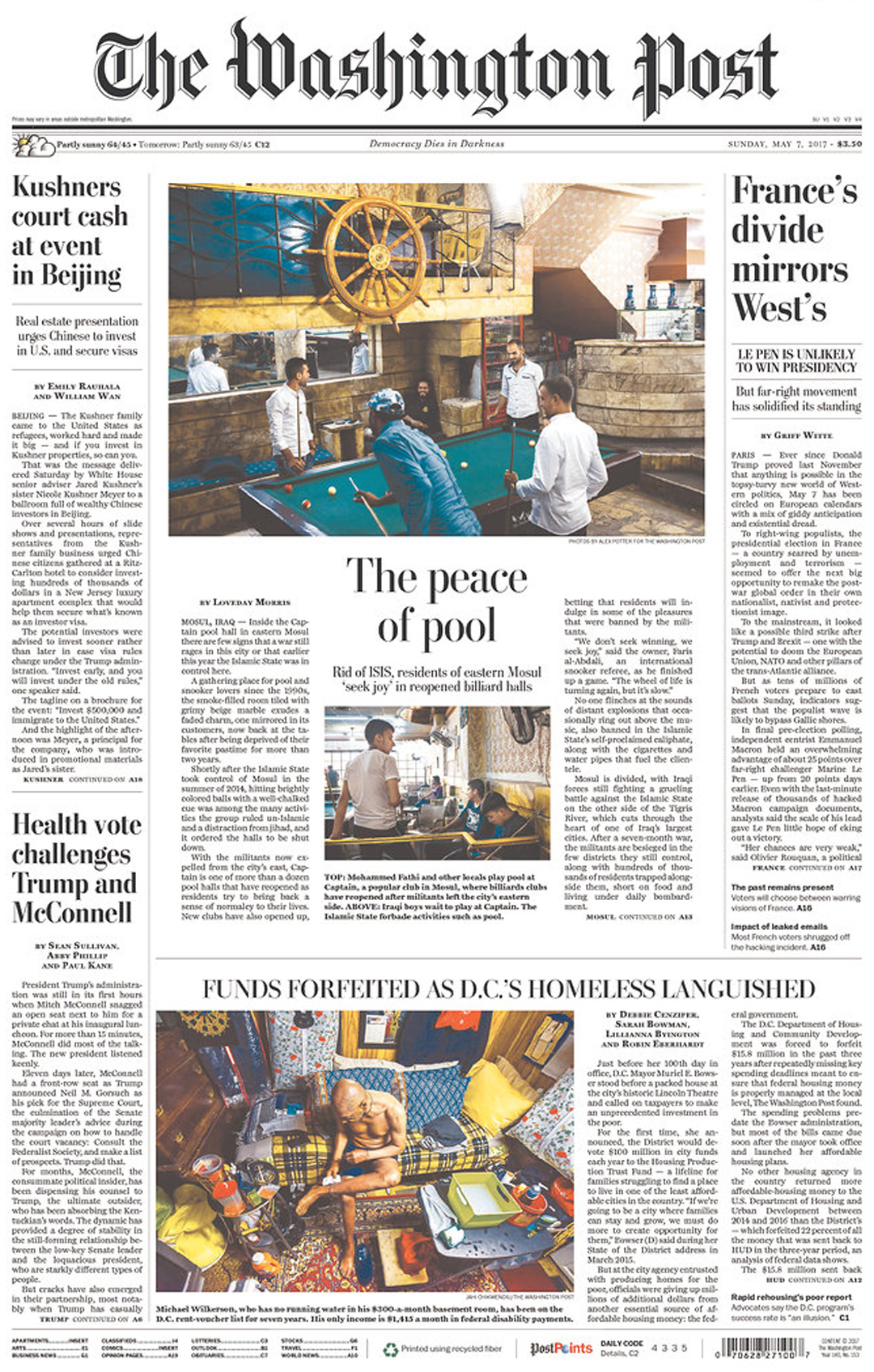By John Perrino
Tired faces slowly file into a small room taking a seat around a table. The editor stands up and explains the next assignments and a hand pops up in the room for a story requiring data journalism.
That’s how the journey to the front page of The Washington Post began for Lillianna Byington, BA ’18, and Robin Eberhardt, BA ’17, in Professor Debbie Cenziper’s “Big City Reporting” class.
Byington and Eberhardt were assigned an investigation into the federal money that local housing authorities forfeited back to the Department of Housing and Urban Development.
This wasn’t just another class assignment. Professor Cenziper is a Pulitzer Prize-winning reporter on the investigative staff at The Washington Post. If her students successfully pursued the story throughout the semester, she would pitch her editor at The Post.
Like any good investigative reporter, the two students set out to follow the money and find the people hit hardest.
First, they poured through federal data to determine how much money local housing authorities across the country were sending back to the federal government. Their findings were shocking — the worst offender was just up the street.
Their analysis found that the D.C. Department of Housing and Community Development forfeited $15.8 million, or 22 percent, of federal funding for affordable housing programs over the last three years — more than any other housing agency in the country. They knew they had a big story on their hands.
Next, the students set out to find the people impacted by homelessness and affordable housing in D.C.
“We wanted to see the tangible impact of the numbers, so that is when we got to talk to the victims and people that are actually impacted by homelessness and the affordable housing,” Byington said.
Their first stop was the D.C. Landlord-Tenants Court. When sitting in on hearings turned up few relevant cases, Eberhardt took to the court hallways. That’s where she first met Carolyn Harrison.
Her story was heartbreaking. The Harrisons were one of the nearly 40,000 D.C. families waiting for rent vouchers. “My kids say, ‘Mommy, what’s wrong? Are we going to be homeless?’” Harrison says in The Washington Post article.
The students continued to gather leads making dozens of phone calls and sending emails to residents affected by the HOME Investment Partnerships Program for low-income housing and advocates.
They built relationships with their interview subjects and traveled across D.C. for in-person interviews accompanied by Professor Cenziper.
Byington and Eberhardt were used to working with the local homeless population.
Byington had interned at Street Sense Media, an organization that reports on and partners with the D.C. homeless population with programming and economic opportunities. Eberhardt’s first assignment at The GW Hatchet was interviewing homeless men and women at a Georgetown shelter and her work continued as the Hatchet’s metro editor.
Still, seeing how the D.C. housing department's management of the money affects people first-hand showed the potential impact of a big story.
“Even for us, it adds faces to the numbers. It is one thing to see these numbers and know how much money that is, but it is another thing to see the direct impact on these people in D.C,” Byington said.
She recalled one interview where a young child was running around the apartment the entire time. “You really see the impact when you see such a little child running around… to go to someone's home and actually see the way they’re impacted in their own living space.”
They had picked up the phone, found the right people to talk with and had the conversations they needed to form the story.
Next came the fact-checking stage of the story, a line-by-line process that took place at the center of The Washington Post newsroom in a glass conference room.
“Sitting in The Washington Post reaffirmed for both of us where we want to go in life, and it’s journalism.”
“We had to double-check everything,” Eberhardt said.
Every sentence was fact-checked with the help of Professor Cenziper and Sarah Bowman, an investigative reporter fellow at the Medill Justice Project.
“We sat in the middle of the newsroom in this conference room and it was a surreal experience because we were able to get the whole Washington Post real-time experience of fact-checking the story. She checked every single fact in it line by line, and it’s a long story so it was a lot of hours, but it was really interesting to watch,” Byington said.
“Sitting in The Washington Post reaffirmed for both of us where we want to go in life, and it’s journalism.”
The team sorted through hundreds of pages of documents and files to find and verify the information included in the story.
During the fact-checking process, they received visits from the story's photographer and editor. “It was funny because they stick their head in and ask when it is going to be done and… said ‘we need to have Marty (Baron) read over this.’ It was really exciting,” Eberhardt said.
Now, the story was fit for print after a final review by the editor. But they still did not know the story would be on the front page of the Sunday edition.
“It was surreal. It’s hard to believe, that’s my name and it’s not just on a piece of paper, it’s on The Washington Post next to our professor,” Eberhardt said.
“I remember in one of my classes freshman year I had to buy The Post every day and read it and now I am on the front page,” Byington said.
They began to hear from D.C. residents and advocates they had never met before and other reporters began to share the article.
Byington and Eberhardt raced to pick up as many print editions as possible — they could still hardly believe their eyes as they read the front-page byline.
, full_html, Tired faces slowly file into a small room taking a seat around a table.




